
Festive caravan of vintage French autos going round Columbus Circle. The “Bastille Day” Celebration in NYC!
Story by Philippe H. Defechereux © 2017
The One Day Every Year When French Unicorns Run Free in New York City Streets
To certain onlookers, they may briefly evoke unicorns, except that their outer surface is often quite colorful and their one horn is inside the car. To hear most New Yorkers who catch a good glimpse, they look more like UFOs on wheels. But not to the numerous French car aficionados, expats or tourists on a visit from France. For them the strange vehicles are quite familiar and a propitious apparition to behold.
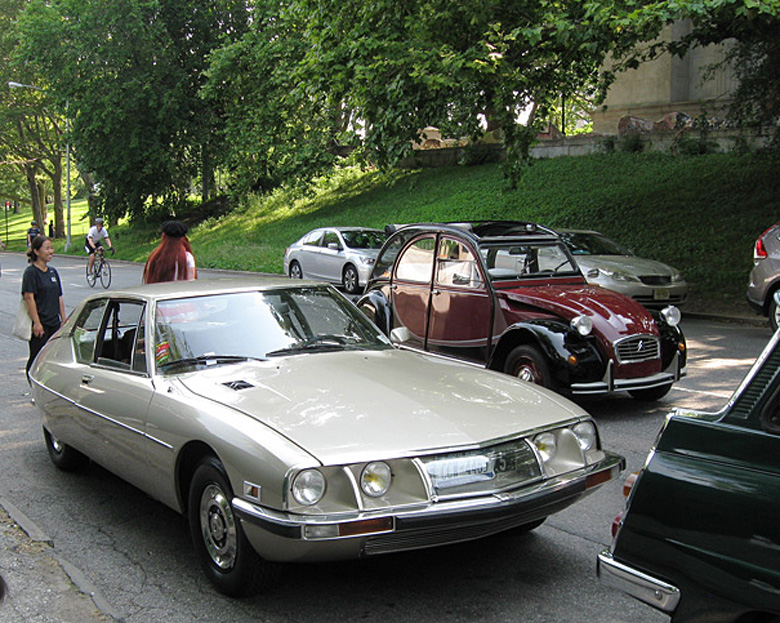
1973 Citroën SM, powered by a Maserati 3.0 L V-6 engine. The SM is at Rally departing point – “Grant’s Tomb” in northern Manhattan. Taller 1980 2CV Charleston next to much longer sister.
Endowed with a look that is at once bizarre and charming, they are the French automobiles of a bygone era; pre-21st century, still dearly remembered, often even regretted. And on that special day of Gallic pride in New York City, the closest Sunday to Bastille Day (July 14), they are very much real on the streets of Manhattan. Real and alive, waving and weaving though dense traffic, French flags aflutter and sometimes drawing eyes as big as crêpes Suzettes.
This is the annual celebration of Bastille Day in New York, the Fête Nationale when the French people, at home and around the world, celebrate the very dawn of their proud nation’s Revolution, July 14, 1789. That day, the Peuple français at last brought down their millennial Absolute Monarchy. They chose to make their point by storming La Bastille, a huge former bastion that, a few days earlier, had been turned into an arsenal for gunpowder and a prison. The huge towered building soon came down, while the precious explosive powder changed hands. France became a Republic; and the bastion’s large footprint was turned into the smooth Place de la Bastille, a major symbolic public circle in the heart of Paris to this day. In New York, Columbus Circle will neatly play the role for the local celebration of that day. (see lead photo)
This year, the “City that Never Sleeps” will mark the 18th edition of this now très chic Annual French Car Rally. Along with a midtown Street Fair, it is organized by the Greater New York Citroën and Velosolex Club, in coordination with the prestigious French Institute Alliance Française (FIAF); it includes the blessing of the Consulat Général de France for New York, located at 934 Fifth Avenue. The Consulat is one of the many stopping and reception points dotting the day-long Rally, as we shall see.
The Bastille Day French Car Run, as it was first casually called, was thought of on a whim over dinner by Howie Seligmann and three friends, francophile residents of northern New Jersey, across the Hudson River from Manhattan. Those four mousquetaires were owners and frequent weekend users of vintage 2CVs (phonetically pronounced “du shu-vo” in French). They always made it a point of honor to drive their unique automobiles around the New Jersey countryside on many summer weekends.
That fateful dinner took place on a late June night and the traditional Bastille Day celebrations in New York City were beckoning. In an inspired post-dinner brainstorm, they decided to lure a few more kindred friends, then stage their own celebration of the French Revolution by starting a much smaller – and more peaceful – revolution of their own: boldly going down nearly the whole length of Broadway (13 miles), from north to south. They would do that in a small pack of 2CV “Charlestons,” one of the last popular version of this French automotive marvel of ingenuity.

Two brave Citroën 2CVs boldly dodging Times Square traffic, powered by their 602cc air-cooled flat-twin engine.
As New Yorkers are always fascinated by the bizarre and strange, especially when it is also pleasing or charming, the French Car Rally caught on quickly. Eighteen years after that first adventurous gamble, the “Annual Bastille Day Rally and Rendez-Vous” is now on the city calendar – July 9 this year, the closest practical Sunday to July 14. The ritual is well set, though in tune with the French spirit, details can change from year to year, or even during the Rally itself.
All the participating cars will assemble early in northern Manhattan, at the parking-friendly General Grant’s National Memorial Park, crossed by West 122nd Street. Scheduled to start at 9 am, the French car caravan, all engines running, then aims almost straight south through the Upper West Side, then daringly through Times Square, then all the way down to Washington Square at West 4th Street; which is the official mid-point rendez-vous. The map below shows the itinerary from last year, typical of most years. Though a seemingly straight and easy north-south course, it is anything but.
Indeed, the Bastille Day French Car Rally, while great fun all day long for participants, is in fact an audacious run in the summer heat through the helter-skelter traffic spine of Manhattan. The course also incorporates many side forays and a few 180-degree “back-northward” detours, by way of one or two east-west city blocks. Sometimes, minor course alterations along the planned route are also mandated by traffic happenstance. Measured at ±15 miles, when it’s all said and done by afternoon’s end, the word “Rally” is not a euphemism; it is definitely earned.
The side forays and detours mentioned above are meant to allow the participants to take an occasional and needed rest at a welcoming place. Those will be the three or four of the many French boutiques and restaurants that sponsor the Rally and are situated along or near its main route. Their owners or managers are only too happy to greet and welcome the participants, sometimes even giving them leave with a neat gift or souvenirs.
Happily, too, the Rally benefits from an official NYPD permit, being part of the official NYC-blessed Bastille Day celebrations. In addition, thanks to the festive atmosphere of that special day, traffic cops are almost always nodding and cooperative when confronted with those four-wheel French UFOs and their high-spirited occupants.

Five Citroëns, three different models, parked seamlessly in front of a French restaurant; not life as usual in NYC…
As mentioned earlier, the mid-point of the Rally is Washington Square, at the delightful park that marks the terminal point of Fifth Avenue. It is an extraordinarily appropriate choice. The famous landmark that dominates the square is the Washington Square Arch, built on the eve of the 20th century, to mark the centennial of the inauguration of George Washington as first President of the United States in downtown New York, in the year… 1789! Not only that, but the New York arch was modeled after the famous Arc de Triomphe built in Paris in 1806… “There are no coincidences,” as a good friend used to say.
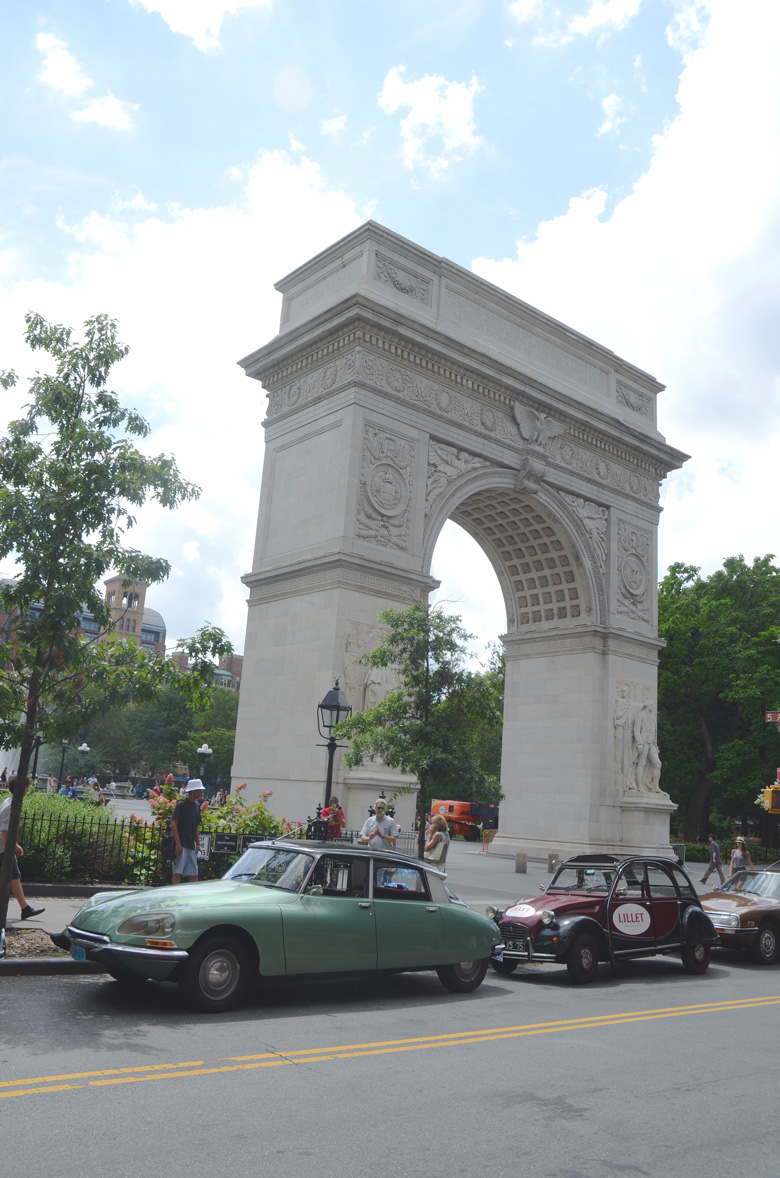
A 1971 Citroën I Super 5 and a 2CV Charleston paying tribute to the George Washington Arch.The Marquis de Lafayette was one of General Washington’s most respected commanders during the American Revolution. Photo credit David LaChance/Hemmings Motor News
The intertwining of French-American relations runs far and deep, well beyond the Marquis de Lafayette’s pro-independence intervention and American return help during the two World Wars of the last century. The Bastille Day French Car Rally in Manhattan marks in its own way a deep and enduring joint parentage between two great nations, even if their automobile cultures took radically different routes after 1945, as we all know.

1973 Citroën DS23 Pallas driving on cobblestone streets, which mean nothing to its hydro-pneumatic self-leveling suspension.
Following a brief rest and a bout of picture-taking under the shading trees of Washington square, the caravan then begins to head back uptown. First, it will stop at an appropriately selected French bistro for a delectable déjeuner, of course. In previous years, the oh-so-typically French mid-day meal was held in the West Village, as the next photo shows below. This off-course location interfered with the itinerary and its timing.
This year, the Coq Rico (30 East 20th Street) in the Flatiron District is the chosen spot where the participants will regain strength and appetite for the second half of the Rally. They are, at this point, only half way to their final destination.
And so, after feasting on savory fare, the participants will return to their beloved automobiles, and drive on further uptown. The next stop is a crowded one: they will join the Bastille Day Street Fair at the southern end of Central Park near the Plaza Hotel, a spot formally known as the Carol C. Freedman Plaza, and extending through the 60th Street block running between Fifth and Park Avenue.

Many Citroëns, including a rare 1971 D Super 5, a successor to the D21, parked near the Street Fair.
Not coincidentally, the proximity to the official Bastille Day Street Fair gives the Rally permission for ample parking space in that landmark spot. As a result, plenty of New Yorkers of all sorts, even those who do not have the slightest idea what that particular summer day’s celebration might be about, can walk by, admire and wonder at those highly unusual but in the end charming and colorful vehicles.

A herd of Citroëns, mostly Traction-Avants, going by Columbus Circle. The T/A Citroën, first manufactured in 1934, was a remarkably innovative car in many ways. It was the first mass-production car (large monthly numbers of units; lower price) to combine three revolutionary features still in use today: a unitary body with no separate frame, four-wheel-independent suspension, and front wheel drive. It played a legendary role in World War II and kept selling well through 1957, when the DS model replaced it.
Next (and it could now be about 3 pm) in the middle of an always exuberant ambiance, every Rally participant – or at least almost all – manages to return to their cars and go for the final leg. That is a run usually up Third Avenue on the East Side of the island, then a turn left and west on 96th Street towards Fifth Avenue, adjoining Central Park at that point. Once they reach the splendid green oasis that is the heart and lungs of Manhattan, they will turn left on Fifth Avenue, heading back south again.
Leaving the artful escargot-like architectural spirals of the Guggenheim Museum to their left at 89th Street, then the colonnaded façade of the Metropolitan Museum of Art to their right past 82nd Street, they will make a stop between 75th and 74th Street. That block of Fifth Avenue facing Central Park is home to the French Consulate General. That office has been headed since last year by Madame Anne-Claire Legendre, a big supporter of the Rally. She is the first woman to hold that important diplomatic position. Vive la France!
When all the félicitations and au revoirs are done, the Rally heads for its final destination: another French restaurant where a well-deserved private party will be held for organizers and participants together. This year, it will be O Cabanon (245 West 29th Street), a self-described “Rustic yet modern French restaurant serving creative plates, charcuterie & wine amid quirky decor.” Prizes and gifts will be awarded to participants who showed the most valor or brought the best car, while many business cards and handshakes will be exchanged. You can also be assured that at this point, with the driving over, much French wine of fine vintage will be consumed.
Lest you think, upon reading the above, that the Bastille Day French Car Rally is composed mostly of various versions and vintages of Citroëns, that is not the case. Peugeots and Renaults, Panhards and Talbots, are most welcome to join next July 9. In fact, a splendidly restored 1938 Peugeot 402 “Légère” was part of the rally last year and it left a great impression. This author also once participated in the Rally riding in a friend’s Peugeot 404 in 2012.
The fact is that the Bastille Day French Car Rally is open to all enthusiasts with a straight record and an appropriate vintage French automobile. Some participants come from New England and even as far as Montréal and Toronto in Canada. The trip from Canada to New York, usually accomplished en groupe, is a Rally onto itself. With a maximum speed of 70 mph on level roads, it takes a 2CV at least two days to complete the trip. Should you be the proud owner of this astonishingly beautiful Citroën DS convertible, however, you could assuredly reach New York from Canada a lot faster.
How to join the Bastille Day French Car Rally and become a Participant:
• Find basic information, click here
• To enter, simply call the dedicated line for quick follow-up: 201-863-7600.
• Alternately, write an email to: velo-solex@USA.net
• Entry, once car and owner(s) are qualified, is entirely free.
• Travel and lodging accommodations are the car owner’s responsibility. The Rally organizers will gladly provide help and guidance.
• Five working days before the Rally’s date in the final deadline to register.
Citroën and Velosolex: What’s in a name
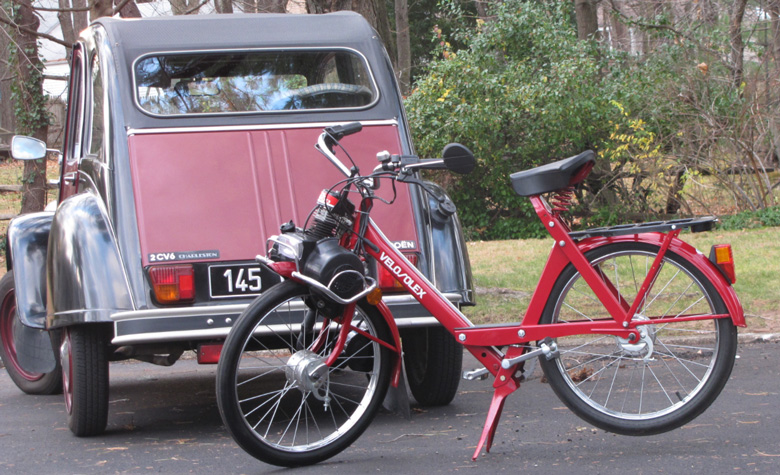
A modern Velosolex motorized bike and a 2CV Charleston; kindred DNA, owned and loved by Howie Seligmann.
Solex became a major French manufacturer of carburetors starting in the early 1920s. Their ingeniously designed critical part for the functioning of the internal combustion engine was used for decades by many famous automobile marques, for example Rolls-Royce, Mercedes-Benz, Citroën, Audi, VW, Volvo, Saab and others. Though Solex made a smooth transition to the new fuel injection technology, it was merged into the Italian Magneti-Marelli company, of which it is still part, in the early 1990s.
Right after World War II, Solex also manufactured a light motorized bike. Called the VeloSolex, it was powered by a tiny two-cycle engine that eventually reached 0.5hp with a displacement of 49cc. Because of its affordable price and maintenance simplicity, it became popular worldwide and sold over 8 million units in 70 countries through the current Millennium. It was still manufactured in France until recently.
The founders of the Bastille Day French Car Rally are also very attached to that machine, so closely associated with Citroën. Hence the New Jersey-based organization’s name and email address.
The author would like to give particular thanks to Howard Seligmann, co-founder of this wonderful annual event, and the leading edge for its continued progress. All photos were also graciously contributed by “Howie” and his team, below:
Tony Behar
Alain Chahine
John Chomitz
Steve Hassa
Stan Honda
David LaChance
Paul Margoles
Ed Merryman
Mitch Seligson




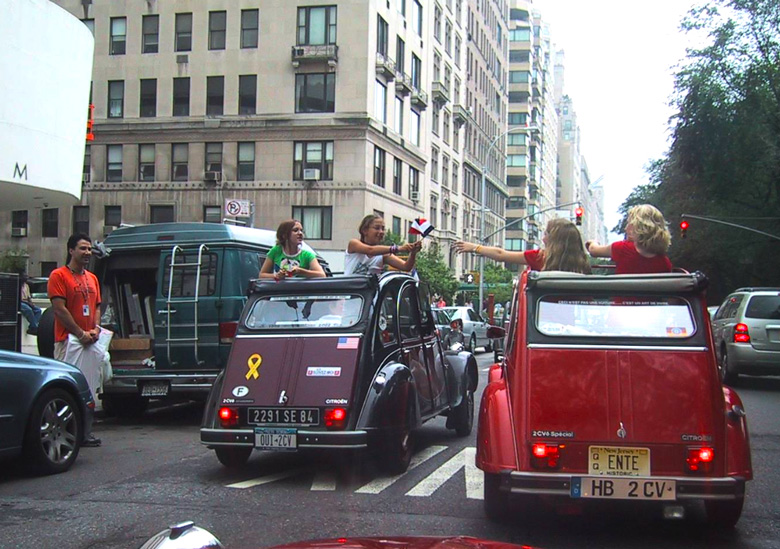
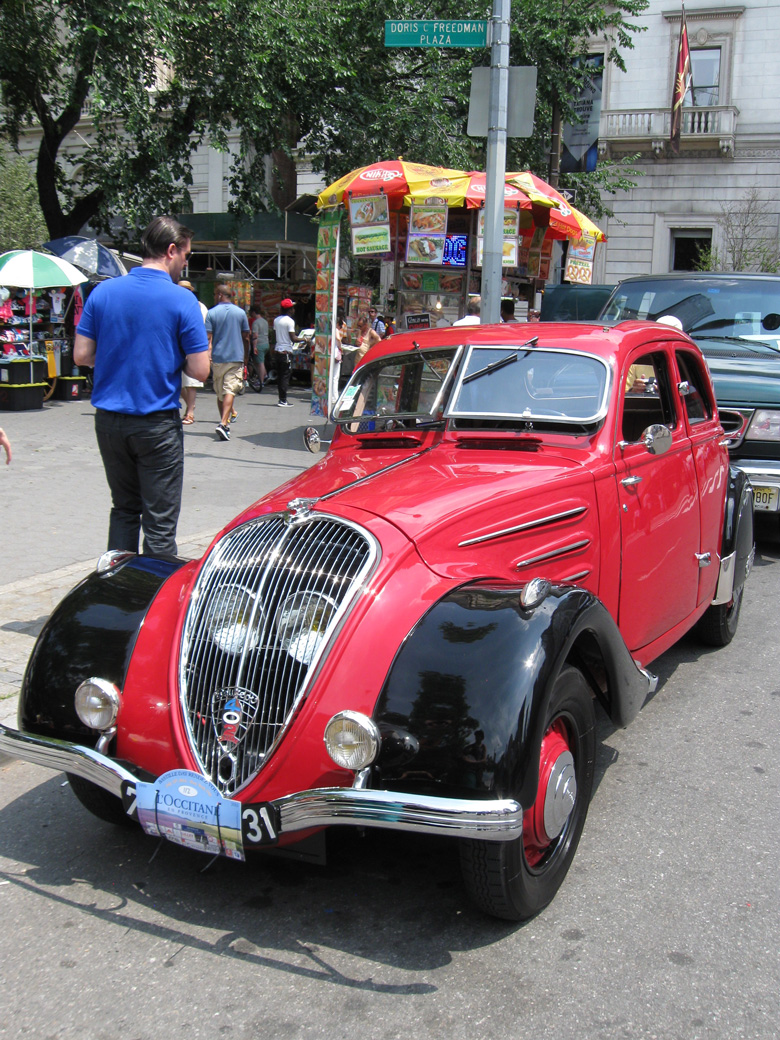
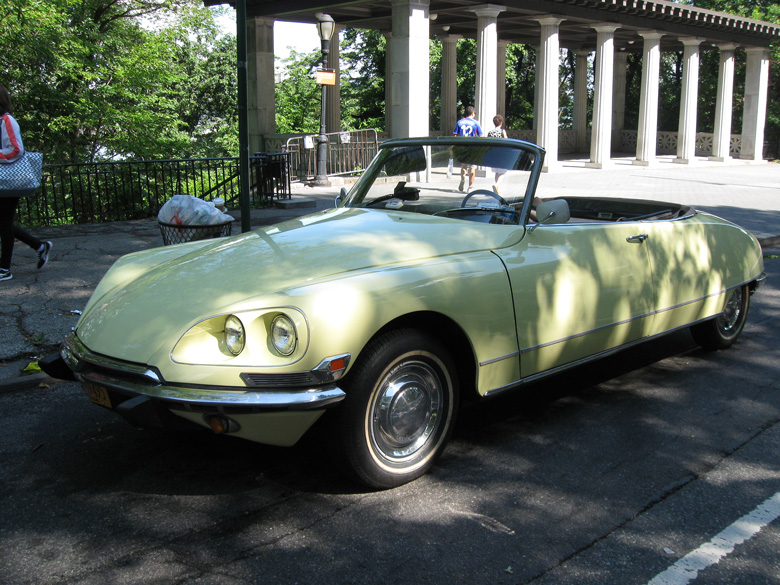
I have to point out that the Lancia Lambda was the first mass produced unibody car with fully independent front suspension, predating Citroen by some years
Keith Humphreys
Yes, that is correct, another friend pointed that out to me before publication. However, very few people remember the Lancia Lambda, neither did it play a historical role during – and after – WWII, on both sides of the conflict – the Gestapo and the French Résistance. Neither was it featured in countless movies filled with great French and even Hollywood stars. Finally, the Traction-Avant sold 760,000 units during its 23-year lifetime (1934-1957). Less than 20,000 Lancia Lambda were sold over a mere decade. Xerox invented the PC with visual interface. It sold a dozen or so units. Steve Jobs and Apple came out with the Macintosh. Who members Xerox today?
Doesn’t matter how many people remember or what social history they have it is an historical fact that Lancia Lambdas were the first.
But surely popularity alone or fame doesn’t change facts? Even if Lancia had only made one Lambda, the fact remains it was the first. It doesn’t matter whether people have heard of it or not. I hope Trump’s ‘alternative facts’ isn’t going to spread through all subjects.
1997 to 2001, as Ambassador for Latvia at the United Nations in NY, I used a Citroen 2CV as my Diplomatic car, parking it most times aside the UK Ambassador’s RR!
Hmmm. Aren’t you ALL forgetting about the 1904 Christie, with a transverse engine, front wheel drive and independent front suspension? In fact his car collided with Lancia, who was still pushing a Fiat, in the 1905 Vanderbilt Cup. And good ol’ Vincenzo made note of the Christie’s independent front suspension.
Editor
Thanks to our Lancistis out there, we’ve clarified the caption about the use of IFS and Citroën. To support his claim of Citroen being the first mass produced car to utilize IFS, the author has done some comparisons on what – at the time – might be considered ‘mass production’:
“In 1929, the Ford Rouge plant produced 28,850 Model A Cars PER WEEK. In that same year, Renault alone sold a total of 45,800 cars. In 1938 Citroën sold 8,000 Traction-Avants. In contrast, Lancia sold a total of 13,000 Lambdas over the car’s NINE-YEAR production run (1923-1931), or an average of 1,400 Lambdas per year.”
One would definitely consider the T/A to be mass produced, but it would take a bit of stretching to consider the Lambda as such.
Editor
As a 1947 Citroën 11 Légère owner I need to qualify the caption; the Traction Avant was predated by the German Adler Trumpf in “pioneering” fwd in a “mass produced” car.
Only the front wheels are independent on the Traction,the rears being on a beam axle,i.e. rigid.With his car Citroën was an early adopter of torsion bar suspension (both ends),the calculations having been performed by none other than Ferdinand Porsche.Its monocoque construction was developed by the Budd company in Philadelphia;there was a representative of that company present at the quai de Javel plant in Paris during the initial production period.
A feature often overlooked is that of wet cylinder liners,not exactly a first but still very rare in 1934.
On a linguistic note Lancia fans are Lancisti, just as Alfa Romeo afficionados are Alfisti; the singular is Lancista and Alfista.The “deux” in 2 CV is pronounced like the eu in Peugeot.Never call these little cars 2 CeeVees in France ,that’s just as wrong as saying Em Kay Two Jaguar. Mk = mark and CV = chevaux. Just trying to educate the colonials you know.
Keep up the good work,
Michel Van Peel